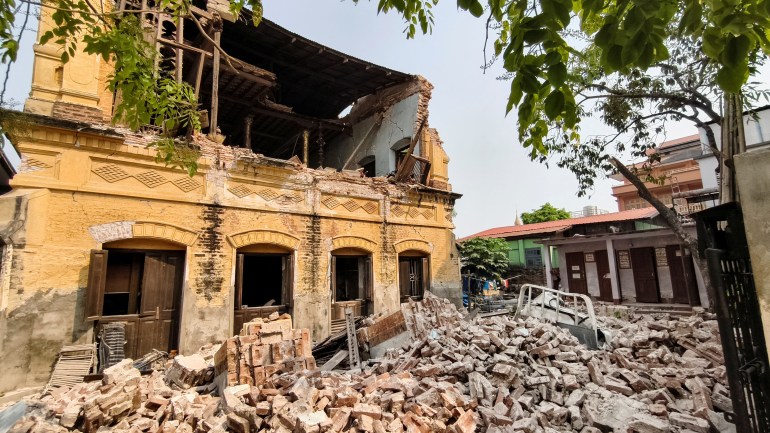Foreign rescue teams and supplies have arrived in Myanmar to help the impoverished country cope with a magnitude 7.7 earthquake that killed more than 1, 600 people and left thousands wounded.
The deadly quake, followed by a second magnitude 6.4 tremor, hit midday on Friday with an epicentre near Mandalay, the country’s second-largest city, bringing down dozens of buildings and damaging infrastructure, such as the airport.
Myanmar’s neighbours – including India, China, Malaysia, and Singapore – dispatched aircraft and warships carrying relief supplies and rescue teams. Thailand, where at least 17 people died due to the earthquake, also sent aid to Myanmar.
On Sunday, a convoy of 17 Chinese cargo trucks carrying critical shelter and medical supplies was expected to reach Mandalay, after making the arduous journey by road from Yangon.
Beijing said it sent more than 135 rescue personnel and experts along with supplies such as medical kits and generators, and pledged about $13.8m in emergency aid.
Two Indian C-17 military transport aircraft were able to land late on Saturday at Naypyidaw with a field hospital unit and some 120 personnel, who were then to travel north to Mandalay to establish a 60-bed emergency treatment centre, India’s Ministry of External Affairs said.
Russia’s Ministry of Emergency Situations said it had flown 120 rescuers and supplies to Yangon, and its Ministry of Health said Moscow has also sent a medical team.

The World Health Organization said it was mobilising its logistics hub in Dubai to prepare trauma injury supplies. The global health body said it was coordinating its earthquake response from its Geneva headquarters “because we see this as a huge event” with “clearly a very, very big threat to life and health”.
The United States, the European Union and the United Kingdom also sent emergency aid.
Meanwhile, an initial report on earthquake relief efforts issued on Saturday by the United Nations Office for the Coordination of Humanitarian Affairs (OCHA) warned that “severe shortage of medical supplies is hampering response efforts”.
‘ No aid in sight ‘
“All military and civilian hospitals, as well as healthcare workers, must work together in a coordinated and efficient manner to ensure effective medical response”, Myanmar’s military leader Min Aung Hlaing said, according to state-run media.
But in some of Myanmar’s hardest-hit areas, residents told the Reuters news agency that government assistance was scarce so far, leaving people to fend for themselves.
The entire town of Sagaing near the quake’s epicentre was devastated, resident Han Zin said.
“What we are seeing here is widespread destruction – many buildings have collapsed into the ground”, he said by phone, adding that much of the town had been without electricity since the disaster and that drinking water was running out.
“We have received no aid, and there are no rescue workers in sight”.
In Mandalay, a rescue worker told Reuters most operations were being conducted by small, self-organised resident groups that lack the required equipment.
Meanwhile, a magnitude 5.1 earthquake hit near Mandalay, the US Geological Survey said, with no casualties reported so far.
Al Jazeera’s Tony Cheng, reporting from the city, said many people slept outside on Saturday night, fearing even brief aftershocks could collapse already severely damaged buildings.
Source: Aljazeera





Leave a Reply